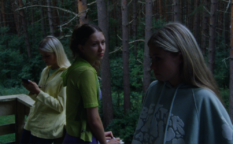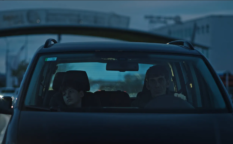Reflections 17
In Mourning with Minari (2021), Kevin B. Lee says, “I don’t want to hunt for images, I want to gather and grow.” It’s a simple but incredible sentence, set against images of the Atlanta area spas where eight people, six of whom were Asian American women, were murdered, and of Steven Yeun cast as Jacob, working the sun-drenched fields of Arkansas in Lee Isaac Chung’s Minari (2020). Hunting is what predators do, and this piece of criticism, Lee lets us know, commits no harm; to gather is to learn and this video seeks to make sense of the stories and lives it presents, it doesn’t take of them; and to grow is to make new – the simultaneous truth and lie of The American Dream. This one, short sentence, barely two minutes in, already says so much about its topic, context, maker, and its own form, that I found myself uncharacteristically pressing pause to mentally unpack its significance. It constitutes just one brilliant thought in Lee’s latest video essay, a work so astoundingly good, it might be his best yet.
I don’t mind saying that this is the kind of criticism I place on a pedestal. I wish I wrote with Lee’s eloquence and edited with his precision. It is no small feat to produce film criticism that speaks with, while to, the visual articulation of its subject. Not only that, but in such a way that it contemplates, precisely and tangibly, everything from the aesthetics and politics of the film, to its real-world impact and counterpoint, whilst also considering the very role and intention of the medium itself. Plus Jung – and I love a bit of Jung.
Mourning with Minari, published by Hyperallergic, and with reference to another incredibly important piece of writing for the site by Peter Kim George, “Minari Isn’t Really About the American Dream. It’s About U.S. Empire”, is my first encounter with the film. I haven’t yet seen it, and I don’t much follow awards ceremonies or their related shenanigans, so I’ve just learnt in watching this video essay of its pending AMPAS American Dream ambitions. Though I am sure I will seek out the film eventually, Lee’s video essay does what I wish so much more so-called film criticism would. The plot and opinion of a movie is no more digestible to me than the marketing team’s synopsis on the back of its packaging. But here, I am asked to really think about the film and its images. And how I have been taught to look at films, and images.
Lee asks, “When I was a student, I was taught that the best stories are those that embody universal values, but whose lives and experiences get to be called universal?” When I was a student, I was taught the same. Though I have always been critical and cautious of figures of authority, including those who (institutionally) taught me how to be critical, I have also been sucked in to thinking that universal values exist. This last year, more than any other in my life, has taught me otherwise. It’s not that the information has become newly available, but that my blinkers have crumbled, and with them my optimism and enthusiasm for much of moving image culture. Especially the industry around which it orbits.
As I write, George Floyd’s murderer has just been convicted. There is some sense of elation – which is honestly terrifying because it speaks to how oppressive the system is, that the conviction wasn’t, until read, a certainty – but there is also still so much pain and sadness because Floyd is dead, and his family continue to mourn. As must the families and friends of so many Black and Asian Americans. And while I, too, am relieved to read of this legal outcome, I can’t help but agree with Minnesota’s attorney general, Keith Ellison, “I would not call today’s verdict justice, however, because justice implies true restoration, but it is accountability which is the first step towards justice. This verdict reminds us that we must make enduring, systemic, societal change.” (The Guardian) Those changes begin with defunding the police to resource real social change, criminalising all forms of police brutality, and changes to gun laws, among a heavy tonne of other things. Those changes are already too late for Daunte Wright, and so many others.
Embodying those so-called universal values that Lee, and I, were taught to admire is not just blinkered, it’s actively dangerous. And what of the counter-images? Police bodycam that is not made public; a friend or stranger who isn’t empowered enough to stop violence but can film it on their smart phone? By this reckoning, that which is not universal is evidence. And in terms of the American Dream, there are too many bodies, unembodied, to count.
Lee says, “My mother would say, ‘If they don’t notice you, they can’t criticise you,’ as if one’s presence among others was already a potential offense.” It is this offense against which embodied evidence must be captured and given. We have to re-frame that which has been cut out.
Widely speaking, though, we haven’t yet learnt to re-frame. “We’ve built the future in the image of the past,” Charlie Shackleton says in A Machine for Viewing (2019), a video essay collaboration with Richard Misek and Oscar Raby, streamed online as a delayed part of MIFF (Melbourne International Film Festival) 68½ – their 2020 online edition of the festival. Shackleton contemplates cinema as a landscape; vertically, horizontally, squared and rectangled. Shackleton speaks to the absence of screen masking – if there is a black space within the frame, to the top, bottom, right, or left, he can’t help but look there and wonder what he’s missing.
Misek and Raby also look for the images and interactions in what’s missing – with reference to Peter Kubelka’s invisible cinema, A Machine for Viewing brings video essay, VR, and cinema together to contemplate the ways in which we interact with moving image. All three essayists engage with a conduit: someone with a VR headset, sitting in an empty auditorium; the view of its screen from the projection booth; a floating camera standing in for the cognition of an empty space; a laptop camera, looking back at looking. All three chapters explore the spatial dynamics of viewing and framing with aplomb, hyper-aware of what they, too, cut out when they Zoom in.
Raby’s chapter is difficult for me to write about, because it takes on the imagined voice of the cinema. And it’s not just any cinema. It’s The Astor. In Melbourne. I grew up and fell in love in that building, over and over again, for years, before I eventually settled in as an employee of George Florence’s, serving the grand old dame (as she once was called) in every possible way – from selling tickets and making popcorn to cleaning bins and stewarding filmmakers like Paul Thomas Anderson and John Landis around. I worked there until the once iconic indie rep house was bought by Melbourne’s pervasive indie assimilation chain, Palace Cinemas. But even as aware as I am of all of my personal attachments to the place, my biggest struggle with Raby’s chapter is that The Astor doesn’t sound Australian. And though the building was home to many things in her now 85 years of operation, including a Greek community cinema and theatre, I just can’t believe that now, empty and alone as she used to be every Tuesday (the one night of the week we’d close), that she doesn’t F and blind, and cackle and caw like a born and bred Melbournian, sitting on land traditionally owned by the Yaluk-ut Weelam Clan of the Boon Wurrung. I’d love to re-cast it with the Boon Wurrung representative for St Kilda, and the City of Port Phillip, Senior Boon Wurrung Elder and Traditional Owner Parbin-ata Dr. Carolyn Briggs AM.
In Mourning with Minari, Lee talks about the shared space of cinematic light, and asks, “Isn’t that what movies are for? To open ourselves to a bigger world and all of the people in it?” Imagine if that were our universal truth.
















